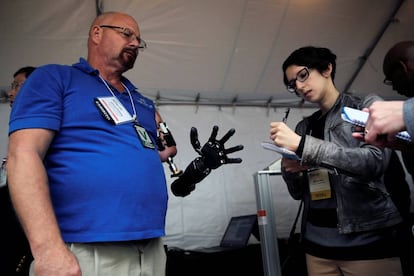DARPA, the Pentagon’s brain
US defense research agency plays key role in developing military hardware and projects straight out of a sci-fi movie

A 40-meter-long crewless ship, a seven-kilo satellite or a device the size of a cellphone that can detect a radioactive leak: they’re still at the planning stage but in a few years they’ll be reality, as has happened already with weather satellites and the internet.
The people behind these projects work for DARPA, the US Defense Advanced Research Projects Agency.
Created in 1958, DARPA has played a central role in driving research within the US armed forces. It came into being after the Soviet Union launched the first intercontinental ballistic missile and put the first satellite in space. DARPA’s job was to make sure that the United States won the space race. And it did.
Since then, the agency has prided itself on having made the United States a global leader in military technological innovation. With a $2.8 billion budget, its job is to recruit talent and finance research. Project leaders are hired for three to five years, which is shorter than other organizations. The tight time frame drives success, says DARPA.
With a $2.8 billion budget, DARPA's job is to recruit talent and finance research
Arati Prabhakar, DARPA’s director, says her team’s motivation is to make the impossible possible: “They think about where the world is headed and how the security environment is changing. We aren’t guided by known requirements, but instead we think about what might be possible but surprising, out of the ordinary.”
DARPA has around 250 projects underway, some 60 of which it showcased at an open day for the Department of Defense community at the Pentagon on May 11. The most revolutionary and controversial projects are kept under wraps, but strolling round the central court of the Pentagon and looking at DARPA’s work, it’s not hard to see where the future of military hardware is going. The collection also highlights the strength of the so-called military-industrial complex that former president Dwight Eisenhower warned about in 1961.
The small town of Arlington, just across the Potomac from Washington and site of the country’s most famous military cemetery, is the capital of the military-industrial complex, and the place where many high-tech manufacturers are located besides DARPA. The agency is always on the lookout for companies to work on its projects, while at the same time convincing the military that it needs them.
Sign up for our newsletter
EL PAÍS English Edition is launching a weekly newsletter. Sign up today to receive a selection of our best stories in your inbox every Saturday morning. For full details about how to subscribe, click here.
DARPA’s Scott Littlefield is manning a stand at the open day and explains how the crewless ship works. It’s called the ACTUV and it was developed in 2012: two years later a deal was signed with the US Navy, and in June it begins two years of trials, controlled from a land base.
Its main selling points are cost and safety. Each ship costs around $20 million, compared to the $1 billion for a conventional vessel of its size. Unlike drones, it’s not armed: its job is to carry out surveillance and detect mines and submarines. “It allows us to take risks, to go to dangerous areas that we can’t enter at the moment,” says Littlefield.
DARPA has saved lives. In 2013, it created 10 million vaccines against the H1N1 virus in a single month, when the normal time frame would have been nine months. But it has also been accused of involvement in a number of controversial projects. In The Pentagon’s Brain, journalist Annie Jacobsen details its activities in brainwashing, the use of the deadly defoliant Agent Orange, and in collecting private data.
The agency is also a pioneer in research into artificial intelligence, and is also looking at how to build a brain “as intelligent, conscious and creative as the human mind,” writes Jacobsen.
English version by Nick Lyne.
Tu suscripción se está usando en otro dispositivo
¿Quieres añadir otro usuario a tu suscripción?
Si continúas leyendo en este dispositivo, no se podrá leer en el otro.
FlechaTu suscripción se está usando en otro dispositivo y solo puedes acceder a EL PAÍS desde un dispositivo a la vez.
Si quieres compartir tu cuenta, cambia tu suscripción a la modalidad Premium, así podrás añadir otro usuario. Cada uno accederá con su propia cuenta de email, lo que os permitirá personalizar vuestra experiencia en EL PAÍS.
¿Tienes una suscripción de empresa? Accede aquí para contratar más cuentas.
En el caso de no saber quién está usando tu cuenta, te recomendamos cambiar tu contraseña aquí.
Si decides continuar compartiendo tu cuenta, este mensaje se mostrará en tu dispositivo y en el de la otra persona que está usando tu cuenta de forma indefinida, afectando a tu experiencia de lectura. Puedes consultar aquí los términos y condiciones de la suscripción digital.
More information
Archived In
Últimas noticias
Cubans look to Venezuela fearfully after Trump’s incursion: ‘We could be next’
The operation in Venezuela to capture Maduro threatens to widen the cracks in the MAGA movement
Trump clarifies who is ultimately in charge in Venezuela: ‘Me’
Maduro pleads not guilty before the federal court in New York: ‘I am still the president of Venezuela’
Most viewed
- Alain Aspect, Nobel laureate in physics: ‘Einstein was so smart that he would have had to recognize quantum entanglement’
- Gilles Lipovetsky: ‘If you want to live better and fall in love, take Prozac, don’t look to philosophy’
- Alvin Hellerstein, a 92-year-old judge appointed by Bill Clinton, to preside over Maduro’s trial in New York
- Cuba confirms death of 32 of its citizens in the US attack against Venezuela
- Why oil has been at the center of Venezuela-US conflicts for decades










































